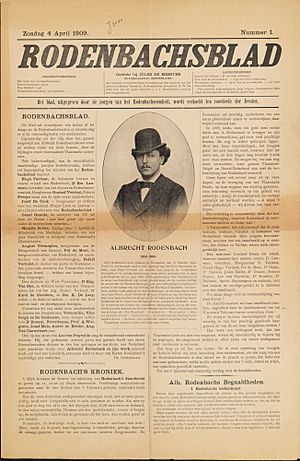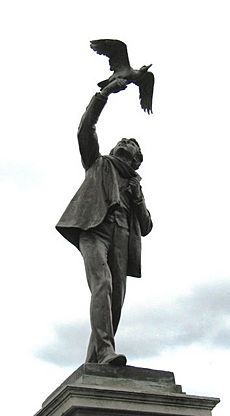Roeselare facts for kids
Quick facts for kids
Roeselare
Roeseloare (West Flemish)
Roulers (French)
|
|||
|---|---|---|---|

Town hall with belfry
|
|||
|
|||
| Country | Belgium | ||
| Community | Flemish Community | ||
| Region | Flemish Region | ||
| Province | West Flanders | ||
| Arrondissement | Roeselare | ||
| Area | |||
| • Total | 59.79 km2 (23.09 sq mi) | ||
| Population
(2018-01-01)Lua error in Module:Wd at line 1575: attempt to index field 'wikibase' (a nil value).
|
|||
| • Total | Lua error in Module:Wd at line 1,575: attempt to index field 'wikibase' (a nil value). | ||
| Postal codes |
8800
|
||
| Area codes | 051 | ||
| Website | www.roeselare.be | ||
Roeselare (Dutch: [ˈrusəˌlaːrə]; West Flemish: Roeseloare; French: Roulers [ʁulɛʁs]) is a city and municipality in Belgium. It is located in the Flemish province of West Flanders. The municipality includes the main city of Roeselare and the towns of Beveren, Oekene, and Rumbeke.
The name Roeselare comes from two old Germanic words. These words mean "reed" and "open space." This suggests the area was once a marshy clearing in a forest. Roeselare is known for its former minor seminary, a type of school. Famous Flemish poets like Guido Gezelle and Albrecht Rodenbach studied there. The city is also home to the Rodenbach brewery, which makes special beer.
Contents
Discover Roeselare's Past
Early Days and Medieval Times
People have lived in the Roeselare area for a very long time. Archeologists have found old flint tools from prehistoric times. They also found Gallo-Roman wells and a small building from the 800s. The name Roslar was first written down in a document from 821 or 822. This document gave the land to Elnon Abbey.
A legend says that Baldwin Iron Arm, a count of Flanders, brought Charles the Bold's daughter, Judith, to a fortress here in 862. This fortress was where Rumbeke Castle stands today. Roeselare soon became part of the County of Flanders. In 957, the city gained rights to build defenses and hold a public market.
Roeselare received its charter of freedoms in the mid-1200s. Around this time, the city built its first city hall and a belfry. Making cloth was the main business then. However, the city's defenses were not strong enough. In the late 1400s, Maximilian of Austria destroyed much of the city. The market hall and Saint Michael church were rebuilt in 1500.
From the 1500s to the 1800s
The 1500s were a tough time for Roeselare. Spanish rulers controlled the Low Countries and did not allow much freedom. In 1566, iconoclasts (people who destroy religious images) attacked the city. They destroyed most of the sacred art. The Eighty Years' War followed, which stopped the supply of wool from England. This caused the cloth industry in Roeselare to disappear.
Things got better in the early 1600s under Archdukes Albert and Isabella. New churches and schools were built, and old ones were fixed. The cloth industry also started to grow again. But the second half of the century brought more wars. Louis XIV and Marshal Turenne fought against the Spanish, leading to more hardship. After the Treaty of Nijmegen in 1678, Roeselare became a border city. This made smuggling more common than regular trade.
The 1700s were generally good for Roeselare. The current city hall was built during this time. In 1794, the French army won a battle against the Austrians here. The French brought big changes, like a new legal system called the Napoleonic Code. They also limited religious freedoms until 1802.

Modern Times and World Wars
Several members of the Rodenbach family from Roeselare helped with the events that led to Belgian Independence in 1830. Other Rodenbachs became soldiers or diplomats. Pedro and Alexander Rodenbach started the brewery that is still open today. The economy faced challenges as machines replaced many small craftspeople.
However, the arrival of the railway and a new canal in the 1860s helped the city. The canal connected Roeselare to the Lys River. World War I stopped this economic growth. Roeselare became a large camp for German soldiers fighting nearby. By the end of the war, British bombing had destroyed two-thirds of the city.
On May 27 and 28, 1940, the Belgian army fought its last battle here against the German Wehrmacht. This led to four years of German occupation during World War II. Luckily, the city did not suffer much destruction this time. Today, Roeselare is an important regional center. It offers shopping, media services, and many jobs in the food industry.
Roeselare's Geography
The municipality of Roeselare includes the city itself and the towns of Beveren, Oekene, and Rumbeke. There are also smaller villages, or hamlets, within the municipality. For example, Zilverberg is a village in Rumbeke, and Beitem is another village a bit further south.
The city of Roeselare has several Catholic parishes (church areas). These include Saint Michael, Saint Amand, Sacred Heart, Saint Joseph, Saint Godelieve, and Saint Mary. There is also a Protestant church in the city.
Roeselare shares its borders with many nearby villages and towns. These include Oostnieuwkerke, Hooglede, Gits, Lichtervelde, Koolskamp, Ardooie, Kachtem, Izegem, Sint-Eloois-Winkel, Rollegem-Kapelle, Ledegem, Moorslede, and Passendale.
Shopping and Fun in Roeselare
The Ooststraat is the most popular shopping street in Roeselare. Special shopping events happen every year. These include the Winkelnacht (Shopping night), kermesse fairs, and Christmas shopping. Many festivals, like a carnival and the Groote Stooringe festival, bring the whole city to life. These events are more than just about shopping.
A long-standing tradition in Roeselare is the weekly morning market. It happens every Tuesday at the main square, called the Botermarkt, and the Polenplein. These areas are connected by traffic-calmed zones where cars drive slowly. On May 1st, Labour Day is celebrated at the Stationsplein.
Places to See in Roeselare
- The rococo city hall is on the central market square. It was built in the 1700s. The city hall, market hall, and belfry are part of a World Heritage Site recognized by UNESCO.
- You can also see a German communications bunker from World War I.
- The Rodenbach brewery started in 1821. You can take a tour to learn how they make their special beer.
- The Renaissance-style Rumbeke Castle dates back to 1538. It is located in the Sterrebos forest. Today, a company called Busworld is based there. The nearby Kazandmolen is the only windmill left from the thirteen that used to be in the area.
- Roeselare also has a unique bicycle museum that you can visit.
- The Canal Roeselare-Leie was finished in 1872. It helps with trade and also offers great places for cycling and walking.
- The Roeselare railway station is an important spot in the city. It has a car-free square and a bus station.
- The Eaststreet is a key shopping street.
Roeselare's Folklore and Traditions
Roeselare is home to a family of giant puppets! The main puppet is Rolarius, who is said to be the founder of the city. His wife is Carlotta, and their son is Opsinjoorke. Many other puppet relatives also join them. These giant puppets appear at festivals and carnivals. They dance to the special giants' song.
There is also a local folk character named Peegie. He is known as a clever merchant. This character is based on the city's history as a trading town in its early days.
Sports in Roeselare
Roeselare was once home to the soccer team KSV Roeselare. They played in the Belgian Second Division until 2020. The city also has a successful volleyball team, Knack Randstad Roeselare, which plays in the CEV Champions League. Famous Formula E driver Stoffel Vandoorne also lives in Roeselare.
Twin Cities
Roeselare is twinned with the town of Clonmel in County Tipperary, Ireland. This means they are friendly partner cities.
Famous People from Roeselare
Many notable people have connections to Roeselare:
- Paul Bulcke (born 1954), a businessman and former CEO of Nestlé.
- Joost Caen (born 1959), an artist who creates stained glass.
- Marthe Cnockaert (1892–1966), a nurse during World War I who also worked as a spy for the British.
- Frédérik Deburghgraeve (born 1973), an Olympic gold medal winner in swimming.
- Rita Demeester (1946–1993), a poet and writer.
- Guido Gezelle (1830–1899), a famous poet.
- Charles Goddeeris, a builder and a key figure in the Flemish community in Detroit, USA.
- Jan Himpe (1921–2007), a musician and composer known for the local song "We zijn van 't oude Roeselare".
- James Lahousse (born 1982), a retired professional soccer player from Belgium.
- Jean-Pierre Monseré (1948–1971), a cyclist and 1970 World Champion.
- Albrecht Rodenbach (1856–1880), a well-known poet.
- Patrick Sercu (1944–2019), a cyclist and Olympic gold medal winner.
- Stoffel Vandoorne (born 1992), a former Formula 1 driver for McLaren and winner of the 2021–22 Formula E World Championship.
- Frédéric Vervisch (born 1986), a racing driver.
- Adrian Willaert (c.1490–1562), a composer from the Renaissance era (though his birth in Roeselare is not certain).
See also
 In Spanish: Roeselare para niños
In Spanish: Roeselare para niños







